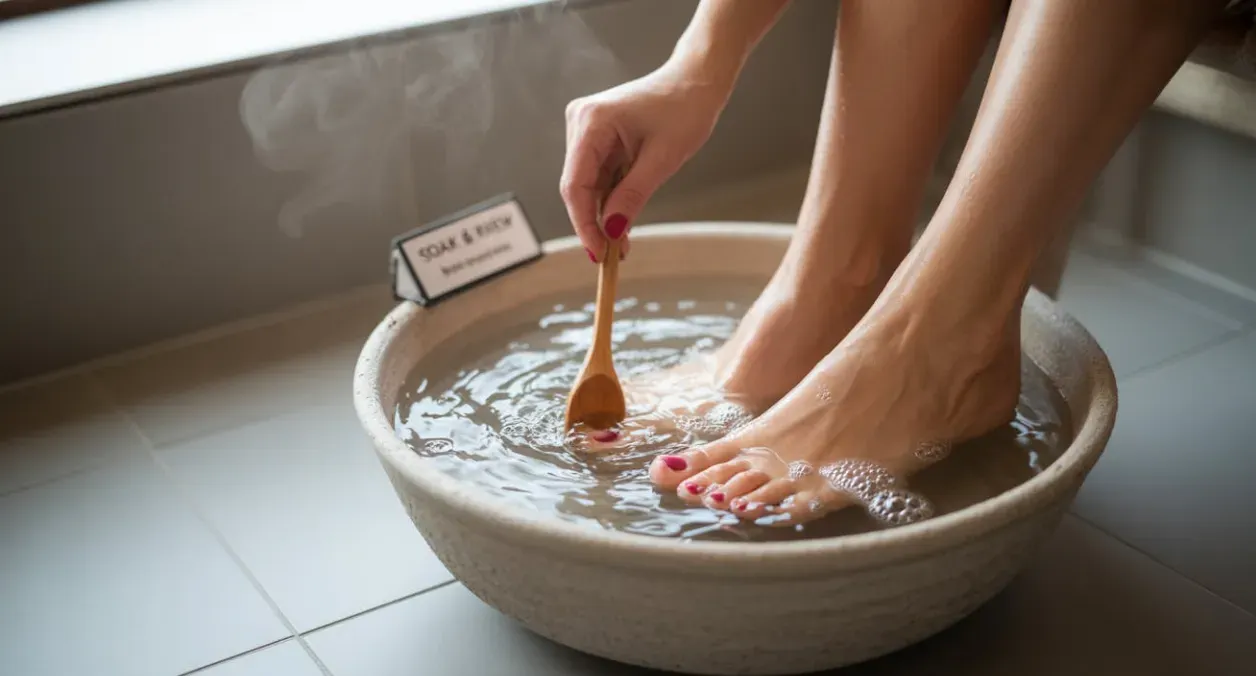7 Cracked Heel Home Remedies That Actually Work (When Done in the Right Order)

Cracked heels are more than just a cosmetic issue — they can hurt, bleed, and even lead to infections. And while many people reach for a foot cream and hope for the best, most treatments fail because they’re done out of sequence. To heal cracked heels properly, you need a complete, step-by-step approach that treats the cause, not just the symptom.
Here’s how to fix your cracked heels at home — naturally, effectively, and permanently — by following a proven seven-step sequence.
Why Your Cracked Heels Aren’t Healing (Yet)
Many people never get long-term relief because they skip crucial steps like exfoliating or sealing in moisture. Worse, internal factors — like poor hydration, bad shoes, or gut imbalances — often go completely ignored.
Cracked heels stem from more than just dry skin:
- Lack of sebaceous glands on the soles (no natural oils)
- Poor sweating due to inactivity
- Nutrient deficiencies
- Hormonal or metabolic imbalances
- Harsh hygiene habits
- Fungal infections or poor footwear
Healing begins when you tackle all of these factors, inside and out.
Step 1: Soften the Skin First — Don’t Skip This
The Right Way to Shower or Soak
Long, hot showers dry your feet out. Instead:
- Keep showers under 10 minutes
- Use lukewarm water
- Opt for natural soap with no fragrances or harsh chemicals
Follow up with a foot soak using:
- Epsom salt (soothes and softens)
- Apple cider vinegar (balances pH and has mild antibacterial effects)
This primes your skin for deeper treatment.
Step 2: Exfoliate to Remove Dead Skin
Physical Tools That Get Results
Once the skin is softened, it’s time to exfoliate:
- Foot file: Controlled removal of thick skin
- Ped Egg: Ergonomic, egg-shaped tool that’s easy to handle
- Pumice stone: Gentle but effective for mild buildup
Creams That Work: Urea, Salicylic Acid, and More
For chemical exfoliation:
- Urea creams (e.g. Flexitol Heel Balm) help break down thickened skin
- Salicylic acid (e.g. Kerasal) dissolves hardened calluses
- Alpha hydroxy acids (e.g. Lactic acid products like AmLactin) smooth and shed dead skin
- Foot peel masks: Shed entire layers of skin over several days
Be gentle — aggressive removal can worsen fissures.
Step 3: Use Deep-Healing Moisturizers and Creams
What to Apply for Deep Cracks and Fissures
Choose products that hydrate and heal:
- Zim’s Crack Creme
- Dr. Teal’s Foot Cream
- Miracle Foot Repair
For deep splits, use:
- Liquid bandage (during the day) to protect and allow healing
- Moisturizing cream (at night) to deeply hydrate
Natural vs. Medicated Creams: What’s Worth Buying?
Look for ingredients like:
- Urea
- Aloe vera
- Tea tree oil (antifungal)
- Glycerin (draws moisture into the skin)
Consistency is key — apply twice daily for best results.
Step 4: Lock in Moisture with Oils and Occlusives
Why Sealing Is a Step Most People Miss
Hydration means nothing if it evaporates overnight. Once you moisturize, seal it in:
- Coconut oil, olive oil, or shea butter provide nourishment
- Petroleum jelly or Vaseline acts as an occlusive layer
Oils, Socks, and Overnight Repair Techniques
Top tips:
- After moisturizing, apply a layer of oil or Vaseline
- Slip on gel socks or cotton socks (yes, this is when cotton is helpful)
- Leave them on overnight to lock in moisture and promote deep healing
Step 5: Supportive Footwear and Hygiene Habits
Why Your Shoes Might Be Making It Worse
Open-backed sandals or unsupportive shoes let the fat pad spread and crack. Look for:
- Shoes with heel cups
- Proper arch support
- Avoid barefoot walking on hard surfaces
Fungal Infections, Socks, and Shoe Rotation
Fungus thrives in moist environments:
- Rotate shoes daily so they can dry
- Spray antifungal spray inside shoes
- Change socks mid-day if your feet sweat
- Wash feet daily with natural antibacterial soap
Step 6: Hydrate and Nourish From Within
How Water, Minerals, and Fats Affect Skin
Dry feet are often a whole-body issue. Drink:
- Half your body weight in fluid ounces (e.g. 200 lbs = 100 oz/day)
- Between meals, not during
Focus on:
- Electrolytes: sodium and potassium (avocado, coconut water)
- Healthy fats: avocado, nuts, olive oil
- Low sugar, high vegetables: inflammation and glycation dry skin out
Foods That Hydrate Your Skin from the Inside Out
Try:
- Avocado daily ("An avocado a day keeps the podiatrist away.")
- High-water veggies like cucumbers, zucchini, and leafy greens
- Avoid sugary drinks and alcohol
Step 7: Address Underlying Health Issues and Gut Health
Medical Conditions That Interfere with Healing
Conditions like:
- Thyroid issues
- Diabetes
- Obesity
- Pregnancy
...can all impair your skin’s ability to regenerate. If your heels don’t improve despite treatment, talk to a healthcare provider.
Gut Health, Stress, and Their Surprising Connection to Cracked Heels
You can eat perfectly, but without good gut bacteria, nutrients won’t be absorbed. Support your microbiome with:
- Fermented foods (kimchi, yogurt, sauerkraut)
- Probiotics
- Prebiotic-rich veggies
Also: manage stress. Chronic cortisol disrupts hormones and skin hydration. Laughter, community, movement, and joy — they’re more therapeutic than we realize.
Final Thoughts: Healing Heels Takes More Than Lotion
Cracked heels are fixable — but they demand more than slapping on a cream. With the right sequence of softening, exfoliating, moisturizing, sealing, and addressing internal health, your heels can not only heal, but stay smooth for good.
Be patient. Be consistent. And always work from outside in and inside out.
